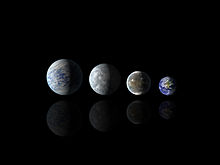This is an old revision of this page, as edited by Tom.Reding (talk | contribs) at 00:37, 4 April 2016 (Undid revision 713425080 by I9Q79oL78KiL0QTFHgyc (talk) If you do not like the idea of arXiv.org being a legitimate source, bring it up at Help talk:Citation Style 1). The present address (URL) is a permanent link to this revision, which may differ significantly from the current revision.
Revision as of 00:37, 4 April 2016 by Tom.Reding (talk | contribs) (Undid revision 713425080 by I9Q79oL78KiL0QTFHgyc (talk) If you do not like the idea of arXiv.org being a legitimate source, bring it up at Help talk:Citation Style 1)(diff) ← Previous revision | Latest revision (diff) | Newer revision → (diff)
The Earth Similarity Index (ESI or "easy scale") is a characterization of how similar a planetary-mass object is to Earth. It was designed to be a scale from zero to one, with Earth having a value of one. The index can also be calculated for large natural satellites and other objects.
The index incorporates the planet's radius, density, escape velocity, and surface temperature. These parameters are not always known with certainty and so must be estimated based on one or more observable features of a planet, but many uncertainties remain. For example, surface temperature is influenced by a variety of factors including irradiance, tidal heating, albedo, insolation and greenhouse warming. Where these are not known, planetary equilibrium temperature can stand-in.
The ESI is designed so a planet with a high ESI (values in the range from 0.8 and 1.0) corresponds to one that is of terrestrial rocky composition. The index does not characterize habitability, although given the point of reference being Earth, some of its functions match those used by habitability measures. As with the definition of the habitable zone, the index uses surface temperature as a primary function (and the terrestrial point of reference).
According to this measure the closest planet to Earth in the Solar System is Mars with an ESI of 0.797. A number of exoplanets have values in excess of this. Kepler-438b has the highest Earth Similarity Index of confirmed exoplanets at 0.88.
Formulation
The index is based on the planetary radius, Bulk density, Escape velocity, and Surface temperature. Thus the index has two components which characterized different aspects of physical similarity. The mean radius and bulk density are associated with the interior, while the escape velocity and surface temperature are associated with the surface.
Planets similar to Earth
Main article: List of potentially habitable exoplanets
Exoplanets dominate the list of known Earth-like objects. However, the classification is made difficult in that many methods of exoplanet detection leave certain planetary features unknown. For example, with the transit method, one of the more successful, measurement of radius can be highly accurate, but mass and density are often estimated; likewise with radial velocity methods, which can provide accurate measurements of mass but are less successful measuring radius. Planets observed via a number of different methods therefore can be most accurately compared to Earth.
Similarity of non-planets to Earth
Main article: List of potentially habitable moons Main article: Natural satellite habitability
The index can be calculated for objects other than planets, including natural satellites, dwarf planets and asteroids. The lower average density and temperature of these objects give them lower index values. Only Titan is known to hold on to a significant atmosphere despite an overall lower size and density. While Io has a low average temperature, surface temperature on the moon varies wildly due to geologic activity.
See also
References
- "HEC: Data of Potential Habitable Worlds".
- "Earth Similarity Index (ESI)". Planetary Habitability Laboratory.
- Schulze-Makuch, D., Méndez, A., Fairén, A. G., von Paris, P., Turse, C., Boyer, G., Davila, A. F., Resendes de Sousa António, M., Irwin, L. N., and Catling, D. (2011) A Two-Tiered Approach to Assess the Habitability of Exoplanets. Astrobiology 11(10): 1041–1052.
- Suresh Chandra; Subas Nepal; Mohit K. Sharma (July 2015). "Earth Similarity Index with two free parameters". arXiv:1507.06293v1 .
- pg 143. Multivariate and other worksheets for R (or S-Plus): a miscellany P.M.E.Altham, Statistical Laboratory, University of Cambridge. January 10, 2013
- Keszthelyi, L.; et al. (2007). "New estimates for Io eruption temperatures: Implications for the interior". Icarus. 192 (2): 491–502. Bibcode:2007Icar..192..491K. doi:10.1016/j.icarus.2007.07.008.
External links
| Exoplanets | |||||||
|---|---|---|---|---|---|---|---|
| Main topics |  | ||||||
| Sizes and types |
| ||||||
| Formation and evolution |
| ||||||
| Systems | |||||||
| Host stars | |||||||
| Detection | |||||||
| Habitability |
| ||||||
| Catalogues | |||||||
| Lists |
| ||||||
| Other |
| ||||||